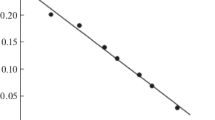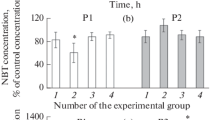Summary
Mycoplasmas (M. gallisepticum, chicken mycoplasmas), in concert with interferon γ (IFNγ), were effective in activating macrophages (Mθ) to be tumoricidal. The Mθ-activating capacity of mycoplasmas was maintained after treatment with heat, 0.1 M NaOH, 1 M HC1, or trypsin. Mθ-activating factor was extracted from mycoplasmas with chloroform/methanol and water (Mf-B). Mf-B was also effective in activating Mθ in the presence of IFNγ. The threshold dose of Mf-B for Mθ of ordinary C3H/He mice and that for those of C3H/HeJ mice, the latter being known to be low responders to bacterial lipopolysaccharide, were actually the same. This seems to indicate that the effectiveness of Mf-B was not attributable to possibly contaminating lipopolysaccharides, and that the pathway of activity of Mf-B is different from that of lipopolysaccharides. Since the Mθ-activating principle was only a very small part of Mf-B, we have not yet succeeded in identifying it, but there was no evidence that it was protein, nucleic acid, sugar, or lipid. The cytotoxicity of Mθ activated by Mf-B plus IFNγ was dependent onl-arginine in the culture, suggesting that arginine metabolites are involved in Mθ cytotoxicity. Mf-B induced a small amount of tumor necrosis factor in Mθ, and this induction was markedly enhanced by IFNγ.
Similar content being viewed by others
References
Alexander P, Evans R (1971) Endotoxin and double stranded RNA render macrophages cytotoxic. Nat New Biol 232: 76
Atkin CL, Cole BC, Sullivan GJ, Washburn LR, Wiley BB (1986) Stimulation of mouse lymphocytes by a mitogen derived from Mycoplasma arthritidis. V. A small basic protein from culture supernatants is a potent T cell mitogen. J Immunol 137: 1581
Bekoff MC, Cole BC, Grey HM (1987) Studies on the mechanisms of stimulation of T cells by the Mycoplasma arthritidis-derived mitogen. Role of class II IE molecules. J Immunol 139: 3189
Beutler B, Tkacenko V, Milsark I, Krochin N, Cerami A (1986) Effect of γ interferon on cachectin expression by mononuclear phagocytes. Reversal of the lpsd (endotoxin resistance) phenotype. J Exp Med 164: 1791
Bligh EG, Dyer WJ (1959) A rapid method of total lipid extraction and purification. Can J Biochem Physiol 37: 911
Boraschi D, Meltzer MS (1979) Defective tumoricidal capacity of macrophages from A/J mice: II. Comparison of the macrophage cytotoxic defect of A/J mice with that of lipid A-unresponsive C3H/HeJ mice. J Immunol 122: 1592
Gallily R, Sher T, Ben-Av P, Loewenstein J (1989) Tumor necrosis factor as a mediator of Mycoplasma orale-induced tumor cell lysis by macrophages. Cell Immunol 121: 146
Hibbs JB Jr, Taintor RR, Vavrin Z (1987) Macrophage cytotoxicity: role forl-arginine deiminase and imino nitrogen oxidation to nitrite. Science 235: 473
Hibbs JB Jr, Vavrin Z, Taintor RR (1987)l-Arginine is required for expression of the activated macrophage effector mechanism causing selective metabolic inhibition in target cells. J Immunol 138: 550
Matthes M, Schrezenmeier H, Homfeld J, Fleischer S, Malissen B, Kirchner H, Fleischer B (1988) Clonal analysis of human T cell activation by the Mycoplasma arthritidis mitogen (MAS). Eur J Immunol 18: 1733
Nakano K, Abe S, Sohmura Y (1986) Recombinant tumor necrosis factor. I. Cytotoxic activity in vitro. Int J Immunopharmacol 8: 347
Proust JJ, Buchholz MA, Nordin AA (1985) A “lymphokine-like” soluble product that induces proliferation and maturation of B cells appears in the serum-free supernatant of a T cell hybridoma as a consequence of mycoplasmal contamination. J Immunol 134: 390
Ruco LP, Meltzer MS (1978) Defective tumoricidal capacity of macrophages from C3H/HeJ mice. J Immunol 120: 329
Ruuth E, Lundgren E (1986) Enhancement of immunoglobulin secretion by the lymphokine-like activity of a Mycoplasma arginini strain. Scand J Immunol 23: 575
Sher T, Rottem S, Gallily R (1990) Mycoplasma capricolum membranes induce tumor necrosis factor α by a mechanism different from that of lipopolysaccharide. Cancer Immunol Immunother 31: 86
Smith PF, Langworthy TA, Mayberry WR (1976) Distribution and composition of lipopolysaccharides from mycoplasmas. J Bacteriol 125: 916
Stuehr DJ, Nathan CF (1989) Nitric oxide. A macrophage product responsible for cytostasis and respiratory inhibition in tumor target cells. J Exp Med 169: 1543
Uno K, Takema M, Hidaka S, Tanaka R, Konishi T, Kato T, Nakamura S, Muramatsu S (1990) Induction of antitumor activity in macrophages by mycoplasmas in concert with interferon. Cancer Immunol Immunother (in press)
Westphal O, Luderitz O, Bister F (1952) Uber die Extraktion von Bakterien mit Phenol-Wasser. Z Naturforsch 7B: 148
Author information
Authors and Affiliations
Rights and permissions
About this article
Cite this article
Takema, M., Oka, S., Uno, K. et al. Macrophage-activating factor extracted from mycoplasmas. Cancer Immunol Immunother 33, 39–44 (1991). https://doi.org/10.1007/BF01742526
Received:
Accepted:
Issue Date:
DOI: https://doi.org/10.1007/BF01742526




